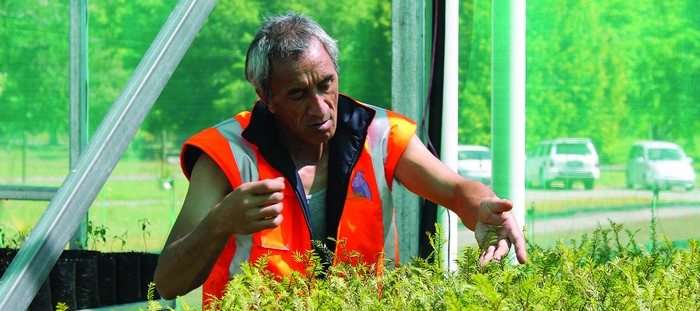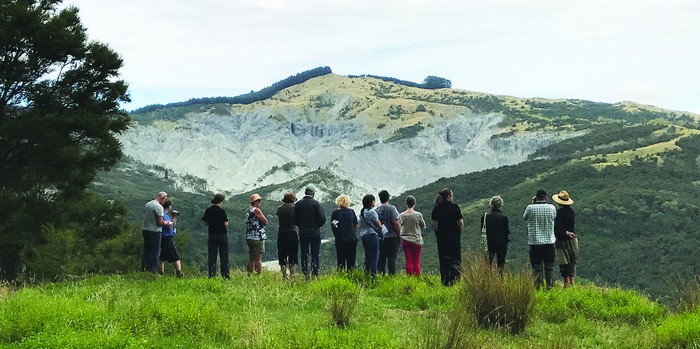Co-innovation and partnering with Māori
Ko te manu e kai i te miro nōna te ngahere. Ko te manu kai i te mātauranga, nōna te ao.
The bird that eats the miro berry owns the forest, the bird that feasts on knowledge owns the world.
“The Ministry of Business, Innovation and Employment estimates Māori enterprise is worth nearly $40 billion, and growing faster than the economy as a whole”3. Forestry is increasingly part of that burgeoning economy. Also, Māori are part of the revitalisation of land and culture with an increasing focus on tree planting as part of restoring the land and improving the resilience of regional communities.
The Government’s increased focus on the regions and trees has had a positive and powerful impact on activities within many partnerships between Māori entities and Scion.
Although many Māori entities are embedded in major programmes being managed by Scion, some partnerships have a unique character and could be pioneering future development of forestry. Examples include forest diversification, indigenous forestry and forest products, land use and a greater focus on community resilience as summarised below.

A step change in indigenous tree propagation
Last year, we reported on the partnership between Ngāti Whare Holdings Ltd and Scion. When Ngāti Whare approached Scion for expertise to design and build a modern nursery in the village of Minginui Te Whaiti they came with a two-fold vision: to produce indigenous trees to replant 640 hectares in the Whirinaki Valley and to initiate employment in the village.
After a 45-year struggle for Minginui to survive after the New Zealand Forestry Service closed, the iwi’s nursery is the new heart of the community and contributes a great deal to Ngāti Whare’s present sense of well-being. Recently the Government announced an investment of $5.8 million to underpin the nursery and all it represents for this region, and to support the Government’s goal to plant a billion trees in 10 years, ensuring that many of those trees are indigenous.
The nursery is also responding to the enormous interest in indigenous trees by piloting an approach for mass propagation of indigenous trees. Mere George, General Manager of Ngāti Whare Holdings, says, “What’s really exciting about the technology is that we might be able to facilitate native forestry. It’s as though the downfall for the community was the cutting of native trees and logging of native timber, but now, the thing that might revive the village is going to be the nursery and effectively replanting the areas that were logged way back then. It has come full circle.”
New sustainable industries based on indigenous trees
The role of indigenous trees in building resilient communities is also being advanced with the work in Te Tai Tokerau where on-farm grown tōtara is being evaluated for its commercial potential in high-value applications with the vision of a sustainable new industry in Northland. This is a partnership across many organisations: Scion, Te Tai Tokerau Māori Forestry Collective, Tāne’s Tree Trust, Northland Inc., Ministry for Primary Industries and the Ministry of Business, Innovation and Employment (Provincial Development Unit).
Diversifying forests
Rotomā No 1 Incorporation (Rotomā) is a Māori owned entity with substantial investment in pine forests on the shores of Lake Rotomā. The entity is exploring new operating approaches ranging from eco-tourism to forest diversification. An important part of developing this vision is the secondment of Scion scientist Lania Holt into the company and evaluating the option to grow the Chilean (gevuina) hazel and European hazel as part of a diversified forest. Rotomā Chair, Nelson Meha says, “A key attraction of this project is the ability for my committee to explore alternative options to pine, whether it be gevuina or eco-tourism. We need to understand what else is out there and what the potential social, environmental and financial benefits could look like”.
Te Urunga o Kea – Te Arawa Climate Change Strategy
Climate change research and strategies gained prominence with the release of the New Zealand Interim Working Party Report (December 2017) and the call for submissions from our government in response to the Paris Climate Agreement global negotiations. A notable factor in the Interim Working Party Report was the absence of an overarching New Zealand strategy and iwi participation. The latter is being addressed by the Iwi Leaders Group who acknowledge that Māori are at an early stage in developing adaptation plans and strategies for climate change.
In parallel, Te Arawa have formed Te Arawa Climate Change Working Group and, in association with Scion, are developing a climate change strategy followed by a research strategy and a prioritised plan.
Scion Social Scientist Marie McCarthy is a member of the working group. She says, “The work connects community to science, to government directions and across global social typologies in an applied conceptual research framework developed from a Te Arawa cultural values framework. There is a need to be at the interface of RS&T as a planned and strategised iwi contributing to the primary objectives of Te Arawa Lakes Trust where the quality of the water is such ‘that you can see the footsteps of the kōura (fresh water crayfish)’, where the land is maximised and the people are up-skilled and mobilised”.
Taking the latest technologies into the forest
Supported by the Vision Mātauranga Capability Fund and working through Ngāti Tūwharetoa scientist Ben Aves, the productivity of clonal radiata pine stock and non-clonal stock in the Lake Taupō and Lake Rotoaira forests was tested. The forest trusts are committed to employing the latest capability and technologies in forest management. Ground-based tree growth analysis, augmented with an airborne laser scanning survey of forest trees, was used to derive a 3D data-point cloud using light detection and ranging technology (LiDAR). From the combined analyses of field and LiDAR data, results confirmed that clonal stock perform better than non-clonal stock within the trusts’ forests in every aspect.
Te Hiku Economic Development Platform
Scion is involved in an economic development project for Te Hiku lands, which is a research project in the Mauri Whenua Ora programme within Our Land and Water National Science Challenge.
The research partners are three of the five Te Hiku iwi that settled a Treaty claim in 2014 including Ngai Takoto, Te Rarawa and Te Aupōuri. Te Hiku iwi have had significant land assets returned to them under settlement, including 20,000 hectares of pine forests and several farms.
A framework is being developed to enable these organisations in their long-term investment planning. The main development issues the iwi are trying to solve are (1) improving the resilience of forestry and agricultural assets by looking at diversifying into higher value products and (2) empowering the iwi with ownership and control of down-stream processing, distribution and market channels.
A key research issue that emerged from these discussions is the inadequacy of current research and industry models to analyse multiple land blocks with multiple land uses for owners with multiple (and often conflicting) objectives. Although Te Hiku Platform is based on the forestry sector, the intention is it can be adapted to other sectors.

Adaptive governance approaches
The Ministry of Business, Innovation and Employment-funded programme Weaving the Korowai, led by Scion, has been using innovative approaches to improve outcomes for Māori specifically in restoration of degraded landscapes and in local economic development. This is using a coordinated agency approach aligned to the aspirations of Ngāti Porou. Based on the Waiapu Catchment on the North Island’s East Coast, this research has used ‘serious game’ approaches and social network analysis to identify shared pathways to lead to best outcomes for all parties. For example, building partnerships that are based on a clear understanding of the context in which decisions are made and the livelihoods of local people.
